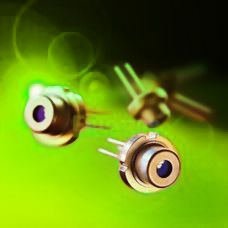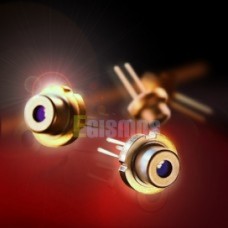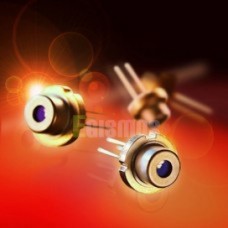Laser Diode

A laser diode (or LD) is a laser light emitting semiconductor device using the properties of a p-n junction. As laser diodes play an important role in optoelectronic applications, Egismos is proud to provide an extensive selection of laser diodes that include Infrared (IR) laser diode, Red laser diode, Green laser diode, Blue laser diode with various wavelengths, packages, and output powers. Egismos range of laser diodes comprises: 405nm, 450nm, 635nm, 650nm, 670nm, 780nm, 808nm, 830nm, 850nm, 870nm, 905nm, 980nm, 1064nm, 1310nm, 1550nm laser diodes from 3mW to 5W C-mount laser diodes.
The term laser is an acronym that stands for "Light Amplification by Stimulated Emission of Radiation". A laser diode is the semiconductor component that emits laser light when input with the right amount of current (threshold).For common use as an electronic component, the laser diode semiconductor chip is usually encapsulated in a casing for its protection and ease of connection to a circuit.
LED are light emitting diodes made from a pn-junction that emits light when a suitable Voltage is applied to its leads. During this state, electrons recombine with holes within the semiconductor device, thereby releasing energy as photons (light particles). The color of the light is determined by the energy band gap of the semiconductor material used for the LED.
The laser diodes have a different structure in that the light is emitted inside a cavity within the semiconductor material. The cavity gives the laser diode its mains characteristics: the Coherence.
The laser light is coherent, which allows the laser to be focused into one tight spot. The laser beams can also stay narrow over great distance, which is called Collimation, which is unique among the light emitting devices. The laser light also has a high temporal coherence, which allows the light to be emitted with a very narrow spectrum (a few nanometers) as opposed to the LED.
The Wavelength is the spatial period of an electromagnetic radiation. Electromagnetic radiations with wavelengths in the range of 400nm to 700nm are perceived by human eye as visible light. Lasers usually show a very narrow wavelength spectrum. For the consumer market, they usually have a wavelength bandwidth of ~1nm, as opposed to conventional light sources that produce white light. White light corresponds to the sum of all visible and invisible (like infrared and UV) waves of the spectrum. A laser diode emits only at a determined wavelength emitted, depending on the semi-conductor material it is made out of..
A laser output power can be measured with a Power meter. Lasers can work in CW mode (continuous mode) or in a pulsed mode. Pulses power can be accounted on the basis of their average power or on the peak power of each pulse. Average lasers power ranges from <1mW for laser pointers and other consumer products to several kW for laser cutting applications or laser weapon systems, etc.
From the first lasers in 1964, it was clear that this light source has a power not only to do the required job, but also it can be very dangerous if operating improperly. Laser safety guidelines were written for consumers, power levels are usually written for visible-light, continuous-wave lasers and are divided into Class 1, Class 1M, Class 2, Class 2M, Class 3R, Class 3B, Class 4. For pulsed lasers and invisible wavelengths, other power limits might apply. In USA it is considered that Class2 lasers are safe for consumers, while EU requires lasers to be Class1. It is suggested for people working with class 3B and class 4 lasers to protect their eyes with safety goggles, which are designed to absorb light of a particular wavelength.
Laser light is coherent, which allows laser beams to be manipulated in order to create many different shapes, from simple collimated beams to complex patterns (created with DOE lenses). Most frequent patterns comprise: laser dot, round dot, laser line, laser cross, ground line. Custom patterns might be achieved through custom optical elements.
Many different fields can benefit from laser technology, such as: medicine, various industrial usages, military applications, consumer products, etc.... Nowadays usage of laser ranges from reading data from a CD or a DVD up to measuring the earth to moon distance.
| Item | Symbol | Definition |
|---|---|---|
| Optical Output Power | Po (CW) | Maximum tolerable power emission under Continuous Wave (CW) operation |
| Pulse Optical Output Power | Po (pulse) | Maximum tolerable power emission under pulsed mode |
| Reverse Voltage | V | Maximum tolerable reverse bias voltage applied to a laser diode For laser diodes with a built-in Photodiode, the Reverse Voltage of the Photodiode V(PD) and that of the laser diode V(LD) can be noted separately |
| Operating Temperature | To | Laser Diode casing temperature range under which the laser diode can be operated safely |
| Storage Temperature | Ts | Laser Diode casing temperature range under which the laser diode can be stored safely |
| Item | Symbol | Definition |
|---|---|---|
| Optical Output Power | Po | Optical Output Power under the specified forward current (If) |
| Threshold Current | Ith | Value of the forward current at which a laser diode starts to emit laser light (lasing) |
| Operating Current | Iop | Forward current input at the specified optical output Power (Po) |
| Operating Voltage | Vop | Voltage input at the specified optical output Power (Po) |
| Peak Wavelength | λp | Maximum intensity wavelength in the spectral distribution of the emitted laser light range |
| Beam Divergence Parallel to the junction | θ// | Divergence of a light beam emitted from a laser diode as expressed as the full angle at half of the peak intensity (FWHM) in the parallel profile |
| Beam Divergence Perpendicular to the junction | θ┴ | Divergence of a light beam emitted from a laser diode as expressed as the full angle at half of the peak intensity (FWHM) in the perpendicular profile |
Laser characteristics (wavelength, operating current) vary with temperature, and variation is more extreme at shorter wavelength.
We recommend installing an APC circuit to maintain a constant output because operating current varies significantly with temperature.
By the same token, laser diodes reliability can be improved by designing products based on their heat release characteristics.
Since the laser diode reliability falls off steeply at a higher temperature, never allow the case to exceed the operating temperature range given in specifications while a laser is in use.
1. It is possible for laser diodes to be damaged by spike current, generated when switching the power ON or OFF or when adjusting its output voltage. Before activating diodes, check the transient state of the power supply to assure that it does not exceed the maximum voltage rating.
2. Operate the laser diodes below the maximum optical output power rating in order to prevent mirror facet damage and resultant loss in reliability.
3. The maximum ratings are specified by case temperature at 25˚C. Design should be made well to work with temperature. As temperature goes up, power dissipation as well as maximum light output power is reduced.
Maximum temperature is set at 260˚C and soldering time is within 3.0 seconds and minimum clearance of 1.6 mm from the root of a lead is necessary.
Prevention of breakdown due to static electricity or surge current
Laser diodes may be adversely affected by static electricity and surge current, which consequently causes breakdown of elements and reduction of their reliability unless the following actions cares are taken:
(1) Power supply, installation and measuring equipment should be grounded. A noise filter or noise-cut transformer is to be provided to power supply input utilized.
(2) During operation, working clothes, hats and shoes should be static-protected when in use. Also, a workman body should be static-protected by use of an earth-band or the like and grounded through high resistance (500K - 1M).
(3) A soldering iron should be grounded to protect laser diodes from voltage leak.
(4) Any container for carriage and storage should be static-protected.
(5) Avoid using laser diodes at a place where high frequent surge current may be generated as an inductive electric field gives breakdown or deterioration. (Avoid being placed around fluorescent grow lamp, for example).




